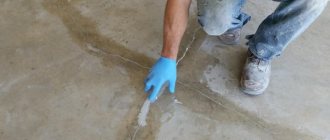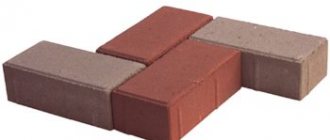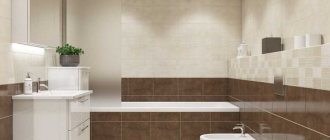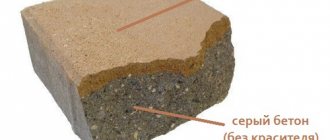Studio kitchens have gained great popularity in the modern world, where, thanks to different floor coverings, it is possible to effectively zone the available space. Most often, tiles and laminate without a threshold are used - this combination of two practical materials looks beautiful and original, and does not cause any particular difficulties during installation. It is important to know what methods of combining them exist and to adhere to a certain technology for laying tiles and lamellas.
Tile and laminate - a beautiful combination in a modern design
Features of creating a transition from tile to laminate
They combine laminate and tiles both in houses and apartments. The connection point may be:
- in the area of the doorway;
- in the kitchen (for example, separating the work area and the dining area);
- in the area between the hallway and the hall;
- between the balcony and the living room;
- near the fireplace (for a beautiful design of the space).
In most cases, ceramics are used to create a practical and safe floor, and laminated boards are chosen because of their high decorative qualities; they perfectly imitate natural wood.
In the classic version, two different floor coverings are joined using a threshold under the door frame. But since such design solutions as separating one functional zone from another - zoning - are now in demand, it becomes difficult to beautifully arrange this conventional demarcation line. Here, one should take into account the harmony of this element with the rest of the interior, and freedom of movement in order to prevent injury to others.
The combination of ceramics and laminated boards looks original in any room
It is problematic to beautifully close the joint between ceramics and slats if the height of the floor coverings is different. This point becomes more complicated, for example, if the thickness of the tile varies between 8-10 mm, plus the volume of tile adhesive is added (it comes out to 12-14 mm), and the thickness of the durable lamella is only 8 mm. Even if a thick underlay is used, it is unlikely that the floor coverings will be equal.
Important! Due to differences in the joint between the ceramics and the decorative coating, particles of dust, dirt, and other debris often collect.
Only with the right approach, using a stretched screed, can you achieve a flat surface against the backdrop of a solid base under the floor covering.
Another feature that should be taken into account when it comes to the junction of tiles and lamellas is the hygroscopicity of the laminated board. If the panels come into contact with moisture, their structure will become loose and they will simply swell. Therefore, the first thing you need to do is lay the tiles, wait until the adhesive dries, and only then start joining with the laminated board. To avoid unwanted consequences, use a sealant that reliably seals the “weak” areas of the lamellas.
Often, due to the physical and mechanical properties of the laminated board, it becomes problematic to fit it tightly to the tile. It instantly reacts to temperature changes in the room and humidity levels. As a result, the lamellas swell and become deformed. To prevent such an outcome, there must be a gap, free space that allows the lamellas to expand.
The seam between the ceramics and the laminate must be neat and fit into the interior
Advice! To ensure a neat line in the area where two different floor coverings join, it is better to use an electric jigsaw or grinder equipped with a diamond tile blade.
Features of installation of flexible thresholds
If framing straight thresholds with a corner causes practically no problems, then the installation of curved connections has some peculiarities. They should be considered in a little more detail. Neither wood nor metal are suitable for these cases due to their inability to bend at any degree. There are two possibilities to connect the laminate floor and tiles: use cork inserts or a complex plastic profile. The cork is easy to install, but its installation requires thorough, thorough preparation. A balsa wood expansion joint cannot cover the imperfections of uneven cutting of laminate or tile edges. In order for the joint to be neat and beautiful, the gap between different coatings should be no more than two millimeters.
The joining surfaces of laminate and tiles are located strictly in the same plane. Their edges are carefully leveled, polished, and very precisely adjusted to one another.
While ceramic tiles do not cause any problems, laminated boards are difficult to process and will require additional labor and time. The result is worth it - joints made with high-quality cork look very beautiful.
For a curved connection, a plastic molding also needs a curved one. It is impossible to purchase one with ready-made radii. Typically, products are sold that have a relatively small bend. To obtain the rail of the required configuration, it must be softened before installation work. This can be done using a hair dryer or simply immersing it in hot water. After such actions, the material becomes pliable and easily bends according to the specified parameters. This profile consists of two parts.
The lower part is attached to the floor along the contour of the seam. It is mounted in parallel with the main covering. On the side of the laminated surface, it is necessary to provide a small gap to create an expansion joint. Since boards can shrink and expand with temperature changes. Albeit insignificantly, but in order to avoid deformations, this must be done. The upper part is carefully connected to the fastening clips located on the lower element. In order not to damage the surface of the decorative profile and floor covering, you should not use an ordinary hammer, but a wooden mallet. Plastic strips are convenient because they can hide a fairly large height difference between the coverings. There are profiles that can eliminate the vertical difference between laminate and tiles up to 18 mm.
Types of transitions between tiles and laminate
The junction of tiles and laminate in a doorway or other chosen location can have almost any form of connection. Among the main types of design of two floor coverings are:
- Straight line. This joint is simple and versatile. It can be decorated with or without a threshold. The length of the line directly depends on the location, under the door or in the zoning area.
- Broken line. This option attracts with its expressiveness, where solid tiles are used without adjustment. Lay the laminated board around according to the existing line. It is very important to maintain precision in the cuts, which will take more time. The use of a threshold in this case is not appropriate; it will only ruin the entire structure. It is especially effective to use such a joint on a long section.
- A curved line. The figured joint between tiles and laminate is actively used by designers when delimiting the kitchen area and the living room. But to bring this idea to life, you will need a professional tool for working on stone and wood. No threshold will be required if the cuts are as precise as possible.
Photos of the transition of tiles to laminate are presented below.
Options for connection nodes
There are several ways to make a technological connection between laminate and tiles:
- Flexible PVC profile - suitable for any curved bends. Consists of a base and a decorative nozzle.
Flexible PVC profile Cezar
Flexible metal profile - most often used on curved sections, but it can also be used on straight seams. They are powder coated for durability.
Flexible metal connecting profile
Aluminum threshold - best suited for installation at the joint under the door leaf. Allows you to hide not only the expansion joint, but also to level out height differences. Some models are powder coated. There are several types of thresholds:
- Thresholds with holes for self-tapping screws are a standard option;
- With hidden fastening - they look more beautiful;
- Self-adhesive - the easiest installation.
Box threshold - it is installed to increase sound insulation, get rid of drafts and to protect against water leakage from the bathroom in the event of a flood. But it is categorically not recommended to do this option: you will hardly notice much of a difference, but you will constantly trip over the 3 cm high threshold.
Door frame with threshold
A T-shaped profile made of solid wood is a beautiful, but expensive pleasure for designing straight seams. The cost can start from 600 rubles per linear meter. Typically used to design the joint between parquet and tiles. Installed with glue.
Solid wood profiles and thresholds
A cork expansion joint is a good option if you want to get an even joint between laminate and tiles without a threshold. Laminate and tiles must be cut as evenly as possible, and a special cork seal is inserted into the expansion joint. It costs about 200 rubles per 90 cm. This option has an obvious disadvantage - over time, dirt will get inside the cracks, which will need to be cleaned.
Cork compensator
PVC transition profile - allows you to accurately arrange a large difference in height between two coverings. First, a mounting profile is installed, and a plug is attached to it.
Transition profiles smooth out abrupt transitions between two coatings
How to join laminate and tiles without a threshold
There are several modern methods that make the joint between laminate and tile practical and original.
How to connect tiles and laminate flooring with grout
This method of designing a joint has a number of advantages, including: low cost, ease of execution and high decorativeness. The grout is suitable for processing complex (winding), shallow joints. For example, there are often flooring options where polygonal ceramic tiles are located on an area with another floor covering.
But not only does this method have advantages, the disadvantage is the high probability of damage to the seam during shrinkage of the building. This is due to the joint being too tight. To prevent cracking of the seam, it is necessary to provide an expansion gap under the baseboard.
Seam processing technology:
- Draw the markings of the future joint on the screed.
- Lay the tiles to the line, having previously adjusted them to size. After trimming, the edge of the tile must be trimmed using a grinder.
- Adjust the laminated board to size and apply silicone to the edge.
- Fill the resulting space approximately halfway with sealant.
- Place grout on top of the dried sealant and level it.
- Cover with clear varnish. This simple technique will extend the life of the seam.
Advice! For greater efficiency, it is recommended to fill the joint between the laminate and the tiles with epoxy grout or polymer grout for porcelain stoneware. As an option, grout for ceramic tiles is suitable.
What the joint between laminate and tiles without a threshold looks like can be seen in the photo.
How to join laminate and tile with sealant
It is still good to seal the gap between the laminate and the tiles with silicone or acrylic sealant, and the second option can be varnished after complete drying. The undeniable advantage of the sealant is its plasticity, due to which two different floor coverings can “walk”. Also, the shrinkage of the building does not affect the sealed seam in any way. The only caveat when using this product is that it is only suitable for a narrow joint, the width of which is up to 5 mm.
The algorithm for sealing the seam between tiles and laminate involves the following steps:
- Cover the edges of the floor covering in the seam area with masking tape (on both sides). This will greatly simplify the process of cleaning up the work done.
- Insert the tube with silicone sealant into a special gun. Fill free space.
- Remove excess product using a spatula. You can also carefully cut them off once they dry.
The time for complete drying of the sealant is 1-2 days. This technology is only relevant for floor coverings that are laid on an adhesive base or fixed with self-tapping screws.
How to close the joint between laminate and tiles with liquid cork
Liquid cork is a fairly popular mixture for decorating the space between the tiles and the decorative coating. It has established itself as a moisture-resistant mass with an interesting texture. A mixture is made from glue and cork chips. It should be used to process seams up to 7 mm wide; the shape can be absolutely any.
Sequence of work:
- Clean the space from particles of dust, debris and degrease.
- Fill the seam with liquid cork. In case of obvious differences in height, level the mass along the upper edge. To avoid having to scrub the floor covering after drying, it is recommended to use oil or masking tape.
- After a day, the seam should be sanded.
When using pressed cork, the laminated board has the opportunity to expand naturally due to its softness and elasticity. The seam turns out neat, but due to the high cost of liquid cork, it is not advisable to use it for shaped joints. In addition, there are restrictions in the choice of shades; when the building shrinks, it can be damaged. If the room area is from 25 sq. m, then the pressed cork is not able to compensate for the expansion of the lamellas.
How to make a transition between tile and laminate using a cork expansion joint
To create a border between two different floor coverings, a cork expansion joint is also used. This can be either a pressed strip or a whole sheet. Among its advantages it is worth noting:
- resistance to house shrinkage;
- sufficient softness of the material;
- aesthetics.
It is especially good to use a cork expansion joint for wide joints, the main thing is that both coatings are at the same level.
Instructions for working with the material:
- According to specific dimensions, you need to adjust the rail.
- Apply the adhesive to the entire width of the laminated board or tile. Place a layer of sealant at the bottom of the seam.
- Insert a cork expansion joint into the gap and treat it with an antiseptic and clear varnish.
Alternatively, the rail can be painted. But due to hygroscopicity, the color turns out to be very bright, which should be taken into account when tinting the material.
Threshold installation process
There are two ways to attach connecting elements between tiles and laminate - open and closed. When open, the threshold is fixed with self-tapping screws through a through hole in the product to the base. The closed method involves the use of a prefabricated structure consisting of a mounting profile, which is attached at the joint to the base and a decorative strip, tightly fixed into the groove of the mounting element.
A method for concealed fastening of a decorative strip without the use of a mounting profile
Straight thresholds
Straight thresholds are the easiest to install - they can be used to tightly close the joint and prevent dirt and moisture from entering it. However, this option has some disadvantages:
- The transition will not be smooth, since the element protrudes above the floor surface.
- More often on sale you can find aluminum straight thresholds, which are not externally suitable for every interior.
- When the fastening is open, the presence of fasteners on the surface spoils the appearance, but on the other hand, the accessibility of the fastening allows you to quickly dismantle the product.
Some manufacturers offer straight thresholds with hidden fastenings. In any case, this type of threshold is quite popular and is a practical way to join two materials.
Direct threshold
Table 3: Direct Connection Installation Process
| Illustration | Description |
| First, measure and cut the element to the required length. | |
| The threshold is applied to the place of future use and markings are made on the floor opposite the holes for fasteners existing on the surface of the part. | |
| Based on the markings, and on the floor along the joint line, mark the places for drilling holes for dowels. | |
| Using a hammer drill, a hole is made. | |
| Install the threshold and secure it with self-tapping screws. |
How to install flexible thresholds
Curved and curved seams are made using a flexible joining strip. In terms of popularity, prevalence and availability, this material, which can easily take any form, is not inferior to its direct analogues.
Flexible PVC threshold
The flexible threshold is a prefabricated structure - the lower part (mounting profile), which has a groove-clip, is fixed inside the joint to the base of the floor, and a decorative insert is snapped on top.
The flexible metal connector between laminate and tile is a little more difficult to install. To do this, first measure and calculate the thickness of the finish, taking into account the adhesive and substrate. You will need to give the required radius to the product manually. Using a hacksaw or grinder, the length of the connecting element is adjusted, and its installation is carried out simultaneously with the finishing work.
Metal finishing flexible profile
Along its entire length, the flexible metal threshold is equipped with special claws, which are inserted under the tile and fixed with adhesive. On the other hand, laminate lamellas are inserted into the groove.
Table 4. Installation process of a flexible PVC threshold
| Illustration | Description |
| At the first stage, the mounting profile is fixed. In this case, it must be fixed smoothly along the radius. Since the mounting profile must be at the same height as the tile and laminate, it may be necessary to remove some of the backing. | |
| The mounting profile is fastened using a self-tapping screw with a small head. | |
| Repeating the radius of the connection, install the laminate and install the threshold. | |
| The threshold, despite its flexibility, is rigid, so when installing it you have to create some force so that it fits into the mounting profile. | |
| It is recommended to use a rubber hammer. To make the work easier, immerse the threshold in hot water for 15 minutes - this will make it softer. |
When installing flooring, combining materials has become a fashionable trend. Curvilinear bends take on the most bizarre shapes.
Advice from professionals
To achieve the desired result when using two different floor coverings, you need to adhere to the following recommendations:
- Ceramic tiles and laminated boards must be in the same plane. In this case, it is worth taking into account both the thickness of the tile composition and the size of the substrate used.
- First you should draw a line, then apply ceramics and lamellas to see the final result.
- First you need to lay the ceramics, and then adjust the laminated board under it.
- It is better to make a figured cut using a grinder. But you should use a tile cutter for an arcuate cut, and an electric jigsaw for a curved one.
Installation Tips
There are several types of thresholds according to the installation method, so we will consider the processes for executing each. Regardless of the installation method, the work will not cause difficulties; the operations performed are simple. The owner will be able to lay the profile himself to design the transition of the laminate panel to the adjacent one.
First of all, let's look at the simplest of thresholds. An important stage is trimming and fitting. As they say, measure twice, cut once.
Through mount
To cut the profile, use a metal file or grinder, angle grinder. After the required length is calculated and cut from the profile, the edges of the cut are cleaned with sandpaper. Then mark the installation location with a pencil or marker.
After the markings are made, holes are made in the marked places. This is where a drill comes to the rescue. Plastic plugs are inserted into the drilled holes. The prepared profile is installed in place and secured with self-tapping screws.
The next type of thresholds are products with hidden installation
If in the case of visible fasteners it is necessary to maintain an equal distance between the screws, in a hidden installation, the main thing is to stick to the same line, the distance relative to each other is not important. The process of preparing a profile of the required length with markings is similar
The holes are marked and prepared. Plugs are inserted into the holes.
Hidden installation
Dowels are inserted into the threshold for hidden installation. After arranging and aligning the dowels with the holes, insert the profile and hammer it in with light blows of a hammer. Do not directly hit the surface of the profile; it is recommended to use a wooden guard to protect the surface. The threshold should be hammered evenly along its entire length to protect against deformation.
Hidden two-piece mount
There is another type of profile with hidden installation - a snap-on strip. The module makes installation faster and easier. Initially, a latch strip is installed on the floor using self-tapping screws, which are screwed into the initially prepared holes with plugs. A threshold is installed on top of the slats. This type of construction makes it expensive, so the element is used together with an expensive laminate.
I would like to note some points about connecting tiles and laminate. The combination is more common than others. For such transitions, an angular threshold is used, which allows you to make a small step between the laminate and the tile.
The use of the structure will additionally protect the tiles from damage. Tile and tile edges are prone to chipping and cracking, and a smooth transition from laminate to tile will prevent this. To avoid damaging the tiles by drilling, it is recommended to secure the threshold with liquid nails.
Joint without threshold
There is another way of joining - laminate without thresholds. Threshold-free installation of panels is carried out if the materials are of similar thickness and shape.
The panels are assembled sequentially one after another or connected to each other without a threshold. Thresholds cause inconvenience and cling. Use sealant or plug to fill the wide gap between the coatings.
Thresholds for laminates are an important element. They perform a protective function and also make a decorative contribution to the decoration of the apartment. When choosing a structural element, consider its height. The part should not protrude much above the surface of the coating, so as not to cause inconvenience when moving. The color of the profile should be in harmony with the laminated coating. It will be better if the colors of the threshold and the floor are in a similar range.
average rating
more than 0 ratings
Share link
Some more tips
- The easiest way to choose a matching threshold is from the laminate manufacturer's collection.
- Sometimes, instead of racking your brains over creating a joint without a threshold, it’s easier to completely abandon the idea of combining dissimilar coatings. For example, if you visually like wood, then you can replace it with practical wood-look porcelain tiles along with a heated floor system. But it’s not worth joining imitation wood (the same porcelain stoneware) with natural wood or laminate, since it’s almost impossible to choose tone-on-tone materials that match the texture.
- It is very important to find a qualified craftsman who has already performed similar work when laying the floor and designing the joint between tiles and laminate.
- Keep in mind that if the room is small (up to 8 sq. m), then combined floors will not look very good, they will visually fragment and reduce the space.
- If you want to combine tiles and laminate in the kitchen, we recommend making a tiled area at least 1 meter wide (from the cabinets with the stove and sink). The photo below shows an unsuccessful example of combined floors - the strip of tiles is too narrow.
- It's best to lay the tiles first. Since it is easier to adjust the level of the laminate to it. In addition, working with tiles is always wet, and this is harmful for the laminate.
Photo gallery
Support the project - share the material with your friends on social networks:Tiles plus laminate for the kitchen
It is unlikely that it would occur to the owner of a typical apartment with a six-meter kitchen to combine flooring. It makes sense to think about such a solution if it is a large room in which the kitchen is combined with a dining room or living room, or if there is a need to visually separate the kitchen area from the living space.
These two materials are easy to work with, so you can handle the task of combining yourself
Such a design, if well thought out, not only looks very advantageous in the interior, but also provides a number of practical advantages.
- The food preparation area is used most intensively : in order to create a three-course meal, the housewife has to “walk kilometers” from the refrigerator to the stove, and from the stove to the sink.
- As a result, the floor covering wears out very quickly if it is, for example, linoleum or even inexpensive wood. Laminate above class 32 is quite resistant to abrasion, but it has a significant drawback. It is slippery, which is even dangerous for the kitchen.
- This is why you need tiles in the work area, preferably porcelain stoneware, on which you can drop any heavy object . The main thing is to choose not polished slabs, but anti-slip ones, with a relief on the front surface - it is more difficult to wash, but you will not slip.
Tile sizes
We present the most successful design options for a combined floor in a studio kitchen.
Tiles with laminate in the kitchen
The kitchen floor is tiles and laminate
Hexagon floor tiles
Another option for designing a joint
Patterned majolica tiles for the kitchen
Porcelain tiles Grasaro Imperador
These photographs show that the designers here sought not only to make the work area more functional, but also to create an accent in the interior precisely due to the flooring. In our opinion, they succeeded. All that remains is to figure out what techniques you need to use so that you can achieve a harmonious design.
Useful recommendations for installing the threshold
The connector must cover the joints and be located under the interior doors. Such a bar will not be visible when the doors are closed. There is always a gap of about ten millimeters between the materials. This is not a flaw in construction work, but a necessity to eliminate stress when the climate in the house changes. Laminate is a sensitive material. It can become deformed due to increased humidity and changes in temperature.
As a rule, there is no problem with the choice of shade and texture of joining strips - the modern construction market offers them in a wide range.
The threshold is secured using self-tapping screws and glue. In most cases, it is better to use a silicone adhesive. It connects smooth surfaces luxuriously. If the component is mounted under the door, it is recommended to cut the strip one millimeter shorter than the height of the door jamb. This approach will minimize damage to the connector if the door is used frequently.
A threshold that matches the color of the doorway - the frame and the canvas - will emphasize its contours and allow you to visually indicate the boundaries of the two rooms.
Using thresholds
Making a joint between laminate and tile using thresholds makes sense in three cases. The first is when the joint is made under the door. In this case, the presence of a threshold is logical and “does not hurt the eyes.” The second option is if there is a difference in height between the two materials being joined. There is simply no other way out.
Don't you think that such a junction spoils the impression?
And the third case. When tiles are laid in the hallway near the front door, and then there is laminate. Even if their levels coincide, it is better to put a threshold here. It rises slightly above the finish and will trap sand and debris that inevitably gets carried in by shoes. This is the option when you can close your eyes to some aesthetic imperfection.
Types of thresholds for joining materials
There are the following thresholds that can be used to close the joint between laminate and tiles:
- Flexible PVC profile. Consists of a base and an overhead decorative strip. The base is attached to the floor at the seam, and the decorative strip is snapped into place. It comes in two types - for joints of materials of the same thickness (maximum difference 1 mm) and for connections with differences (the difference can be 8-9 mm).
Using a PVC profile to create a seam between tiles and laminate
How to arrange the transition of tiles to laminate
Aluminum thresholds are used on straight sections
It just seems like there are few options. There are all these thresholds in different sizes and colors, with different fixation systems. There are a lot of them in big stores.
Installation of flexible PVC profile
As already mentioned, a flexible PVC joining profile consists of a base and a decorative lining, which is held on it due to elastic force. It must be installed after the tiles have been laid, but before installing the laminate.
This is what the junction looks like in cross-section
First, a base is installed along the cut of the laid tile. It is attached to dowels or self-tapping screws. Choose fasteners with flat heads so that when screwed in, they hardly protrude and do not interfere with installing the trim.
The installation process is as follows:
- The base of the flexible PVC profile is laid along the edge of the tile. Its top edge should be flush with the finishing surface. If necessary, you can cut off a strip of backing under the laminate.
- The base is attached to the floor.
- If installation of dowels is required, the fastener installation points are marked, the profile is removed, holes are drilled, and plastic tabs are installed. After which you can screw the base.
When using self-tapping screws, pre-drilling may be required (depending on the type of base). The fastener installation step depends on the degree of curvature of the joint. The base of the connecting profile must exactly follow its outline.
When installing PVC tape you have to make serious efforts
Using a flexible PVC profile, the joint between laminate and tiles is easy to seal. Outwardly, of course, not everyone likes it, but the installation is simple.











